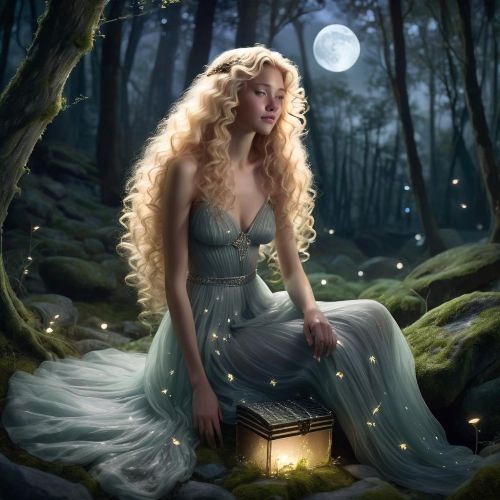Asturian Spirits
Asturian Spirits are a captivating element of the mythology and folklore of Asturias, a region in northern Spain known for its rugged landscapes and ancient traditions. These mystical beings are believed to inhabit forests, mountains, rivers, and ancient ruins, acting as protectors, guides, or sometimes tricksters. Asturian Spirits often reflect the deep connection between humans and nature, embodying the mysteries and powers of the natural world. They appear in countless legends, revealing the values, fears, and beliefs of the Asturian people while shaping cultural identity across generations.
In Asturian mythology, spirits of the natural world are particularly significant. Forest-dwelling entities are often depicted as guardians of trees, animals, and hidden treasures, rewarding those who show respect to nature and punishing those who exploit it. Mountain spirits, meanwhile, are associated with protection, endurance, and the rugged beauty of the landscape, reflecting the harsh but majestic environment of Asturias. Rivers and springs are also believed to be inhabited by spiritual beings, guiding travelers and providing sustenance, while reminding humans of the sacredness of water. These stories highlight the intimate relationship between the people and their environment, where every element of nature could harbor a spirit.
Asturian Spirits are not always benevolent. Many myths describe mischievous or vengeful entities that challenge human morality and test courage. Trickster spirits are often involved in tales that teach lessons about humility, respect, and ethical behavior, while vengeful spirits may arise from unresolved injustices or untimely deaths. Ancestor spirits also play an important role, acting as guides and protectors of families, emphasizing the importance of lineage, memory, and respect for those who have passed. Through these interactions, the spirits help maintain moral and social order, reflecting the values and concerns of Asturian communities.
The presence of Asturian Spirits in folklore has also influenced traditional practices and celebrations. Local festivals, songs, and dances often incorporate the presence of spirits, celebrating their influence and seeking their favor. Shamans, wise elders, and storytellers acted as intermediaries, passing down knowledge of these beings through oral traditions. Stories of Asturian Spirits were used to educate children, entertain communities, and preserve a sense of wonder and respect for the unseen forces that govern life. The legends continue to emphasize the balance between humans and the natural and spiritual realms, showing that the world is alive with powerful entities.
Today, Asturian Spirits remain a vibrant part of cultural heritage and continue to inspire art, literature, and modern media. Their influence can be seen in contemporary storytelling, fantasy literature, and regional festivals that celebrate ancient traditions. These spirits embody the mystical essence of Asturias, offering a link between the past and present while highlighting the ongoing fascination with the supernatural. By exploring the myths of Asturian Spirits, one gains insight into a rich cultural landscape where nature, morality, and the supernatural intersect, keeping alive the enduring power and mystery of these legendary beings.
Asturian Spirits are a captivating element of the mythology and folklore of Asturias, a region in northern Spain known for its rugged landscapes and ancient traditions. These mystical beings are believed to inhabit forests, mountains, rivers, and ancient ruins, acting as protectors, guides, or sometimes tricksters. Asturian Spirits often reflect the deep connection between humans and nature, embodying the mysteries and powers of the natural world. They appear in countless legends, revealing the values, fears, and beliefs of the Asturian people while shaping cultural identity across generations.
In Asturian mythology, spirits of the natural world are particularly significant. Forest-dwelling entities are often depicted as guardians of trees, animals, and hidden treasures, rewarding those who show respect to nature and punishing those who exploit it. Mountain spirits, meanwhile, are associated with protection, endurance, and the rugged beauty of the landscape, reflecting the harsh but majestic environment of Asturias. Rivers and springs are also believed to be inhabited by spiritual beings, guiding travelers and providing sustenance, while reminding humans of the sacredness of water. These stories highlight the intimate relationship between the people and their environment, where every element of nature could harbor a spirit.
Asturian Spirits are not always benevolent. Many myths describe mischievous or vengeful entities that challenge human morality and test courage. Trickster spirits are often involved in tales that teach lessons about humility, respect, and ethical behavior, while vengeful spirits may arise from unresolved injustices or untimely deaths. Ancestor spirits also play an important role, acting as guides and protectors of families, emphasizing the importance of lineage, memory, and respect for those who have passed. Through these interactions, the spirits help maintain moral and social order, reflecting the values and concerns of Asturian communities.
The presence of Asturian Spirits in folklore has also influenced traditional practices and celebrations. Local festivals, songs, and dances often incorporate the presence of spirits, celebrating their influence and seeking their favor. Shamans, wise elders, and storytellers acted as intermediaries, passing down knowledge of these beings through oral traditions. Stories of Asturian Spirits were used to educate children, entertain communities, and preserve a sense of wonder and respect for the unseen forces that govern life. The legends continue to emphasize the balance between humans and the natural and spiritual realms, showing that the world is alive with powerful entities.
Today, Asturian Spirits remain a vibrant part of cultural heritage and continue to inspire art, literature, and modern media. Their influence can be seen in contemporary storytelling, fantasy literature, and regional festivals that celebrate ancient traditions. These spirits embody the mystical essence of Asturias, offering a link between the past and present while highlighting the ongoing fascination with the supernatural. By exploring the myths of Asturian Spirits, one gains insight into a rich cultural landscape where nature, morality, and the supernatural intersect, keeping alive the enduring power and mystery of these legendary beings.


